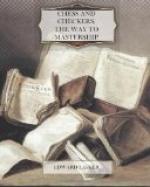(36) P-f4 Pxf4 (37) Kxf4 K-c5 (38) P-h5 Kxc4 (39) K-e4 P-b5 (40) P-a3 K-c5 (41) Resigns.
V
PROBLEMS
To offer an exhaustive treatise on the manifold varieties of Chess problems is not within the scope of this book. The intention of the author is merely to make it quite clear to the reader that the Chess problem, apart from the moves of the men, has no relation to the game and to illustrate the vast difference between problem combinations and positions and game combinations and positions by a few typical examples from the works of master composers.
The mating methods and mating positions in the actual game very rarely embody an element of surprise. They are all known from previous experience and the question is merely whether the player concerned is familiar with them. With the problem it is altogether different. Here the mate must be accomplished in a certain number of moves from a given position in some ingenious way which is not known from game practice, or, if the mating method is not extraordinary, the mating position must be surprising and unlooked for.
Moreover, a number of laws must be obeyed in problem composition, which by the general consent of problemists, or rather by natural evolution of a more refined taste, have become the standards by which the merits of a problem are judged.
There is first of all the law of economy in material which demands that the idea of the problem should be expressed with the least possible number of men, and that no pieces should be added for the mere sake of increasing the number of variations. Then, of course, a problem should have only one solution. A position which has more than one key move is not considered a problem, because the main point at issue in a problem is not the number of moves in which the mate is accomplished but the method in which it is accomplished, and of two possible solutions one will always be prettier so that the existence of the other must necessarily appear a blemish.
A very important law is that the first move of White (who by general consent has always the attack) must not deprive the black King of a flight square, as this would be too brutal, too obvious a procedure. The more possibilities of defense are left to Black the more surprising is the solution and the finer is the problem.
Many problem solvers are under the false impression that the first move in a problem must not be a check. This argument is valid only when by the check the number of defensive moves is limited, but this is not necessarily the case, as can be seen for instance in problem No. 2, in which Black has to move his King anyway, there being no other black piece on the board.




